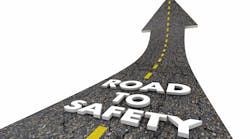Safety is one of those things we all talk about, and I don’t think there is a fleet out there that wants to operate in an unsafe manner. However, in order for a fleet to be as safe as possible, they must have a safety culture that starts at the very top of the organization and is embraced by all employees at every level.
The National Surface Transportation Safety Center For Excellence’s recently released an Effective Strategies To Improve Safety study of nine motor carriers that reported a company’s overall safety culture was a critical element in safe fleet operation.
So what does it take to build a safety culture? According to the report, here are some of the things you need.
- Hire safe drivers: Prioritize applicants’ driving records. Look at prior crash records as well as the number of violations they have received. Perform reference checks and review motor vehicle records.
- Train on safety during new driver orientation: This is the time to introduce your safety culture. Emphasize the importance of pre- and post-trip inspections, talk about your safety program, inform drivers about the safety technologies you have invested in, review Hours of Service rules, explain the disciplinary actions that are in place for safety violations and let them know what they have to do in the event of a crash.
- Conduct periodic ongoing training: All drivers need to have safe driving practices reinforced from time-to-time. Use these training sessions to review defensive driving techniques, talk about driver health and wellness issues and give advice on ways to manage fatigue. Make sure your drivers know your door is always open to discuss safety-related concerns.
- Invest in technology: There are a variety of safety technologies that you can invest in including adaptive cruise control, lane departure warning systems, blind-spot warning devices, speed limiters, collision mitigation systems, etc. Remember that for companies with the strongest safety culture, cost is not a factor when making safety decisions.
- Maintain vehicles: Make sure all vehicles are PMI compliant and that problems surfaced on DVIRs are taken care of quickly. A well-maintained truck is a safer truck.
- Benchmark your safety efforts: Look at what is working well along with what is not. Make adjustments to your safety policies and practices as needed.
The report found that there is no one single fix to ensure your fleet operates safely, rather you need a comprehensive approach to safety. People at the top levels of the organization need to regularly communicate the value your fleet places on safety and must spearhead the move to a safety culture. That way the entire organization will understand your commitment to safety and will take the necessary steps to be safe on the road.



